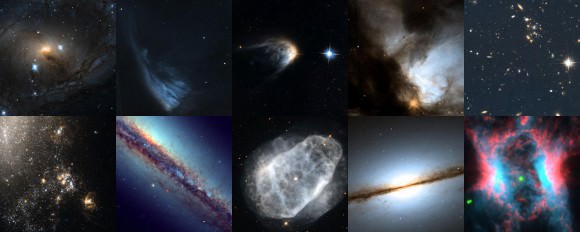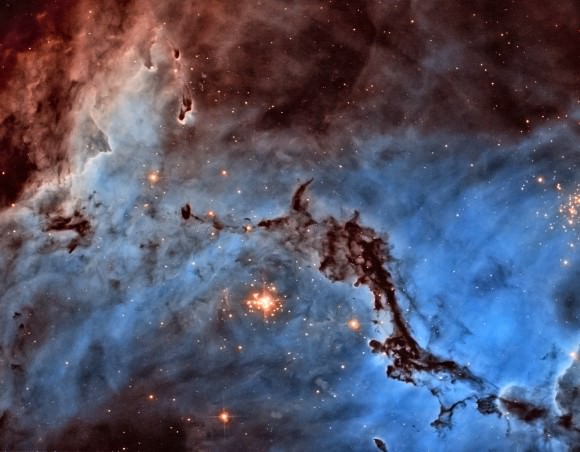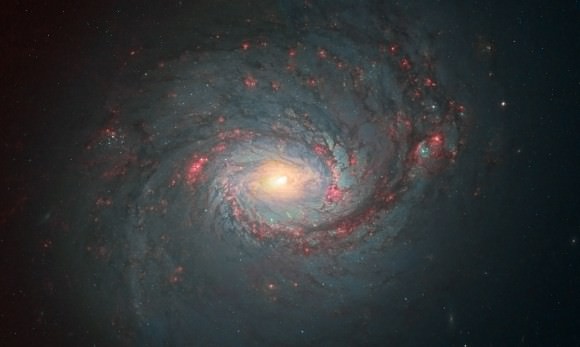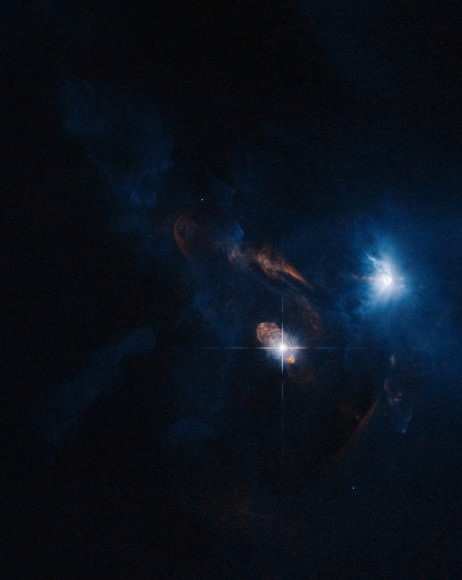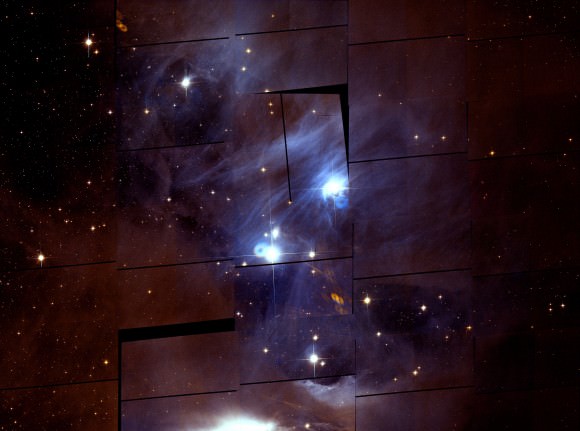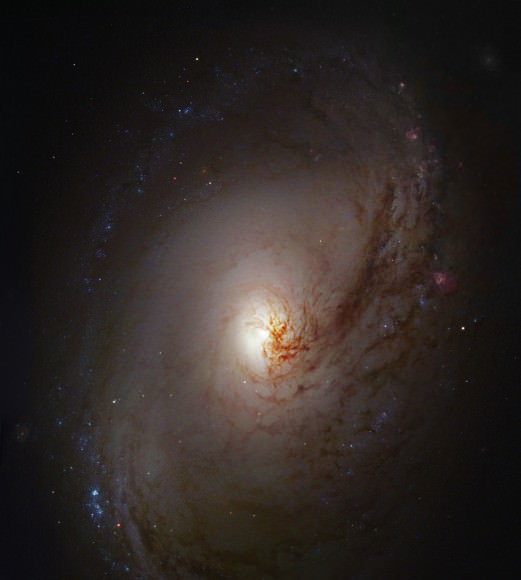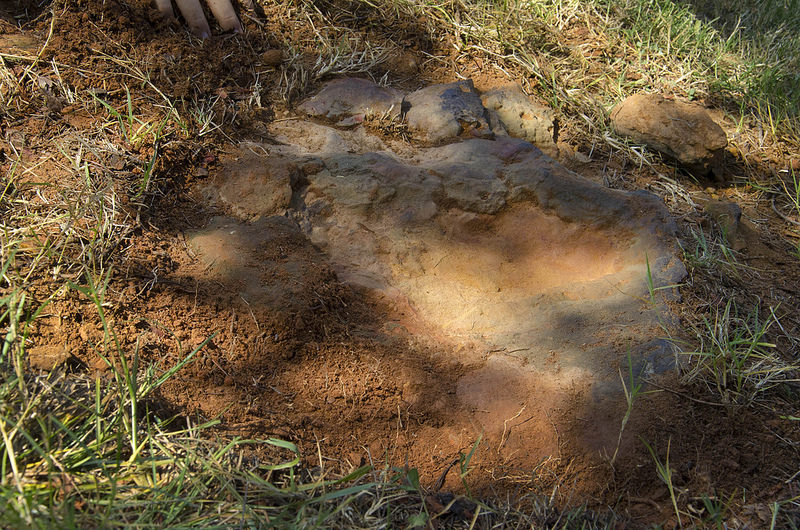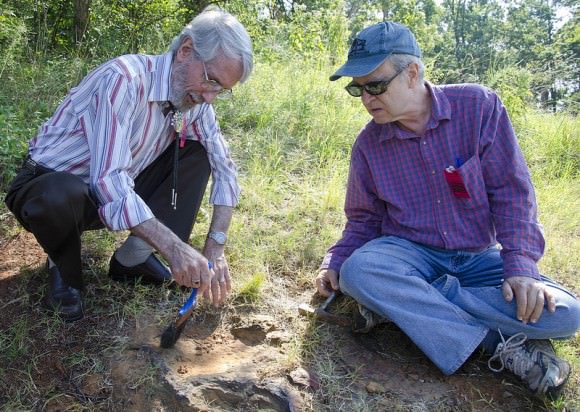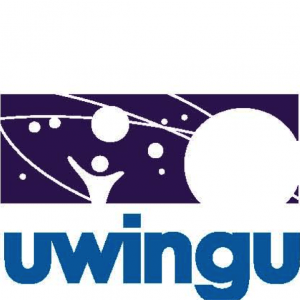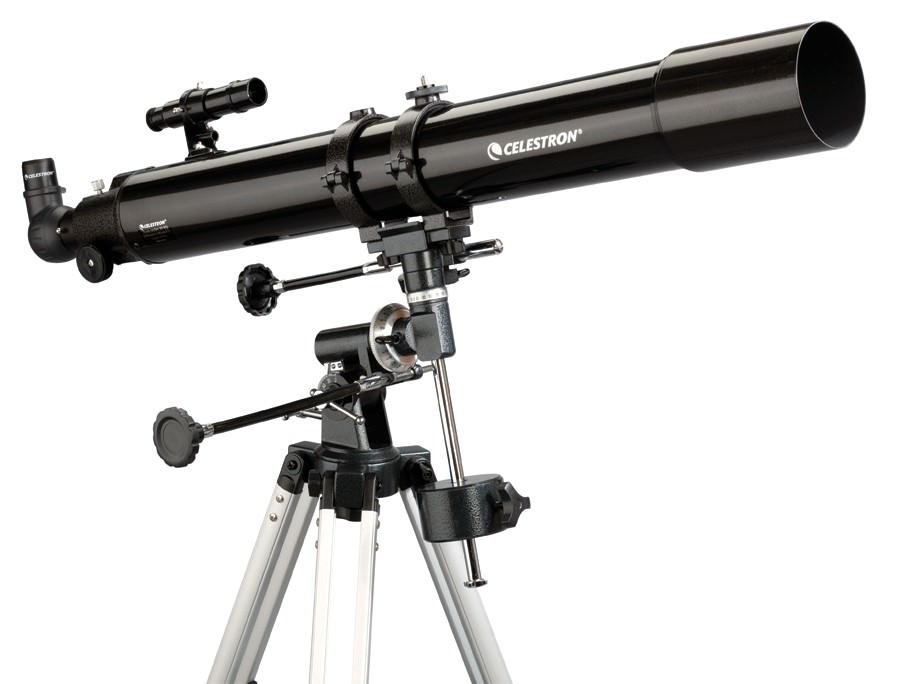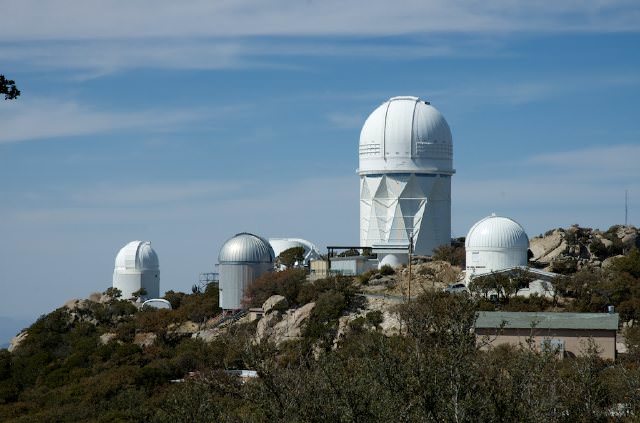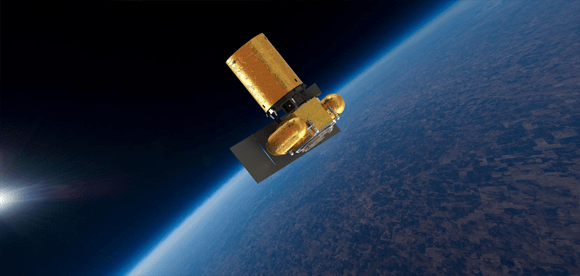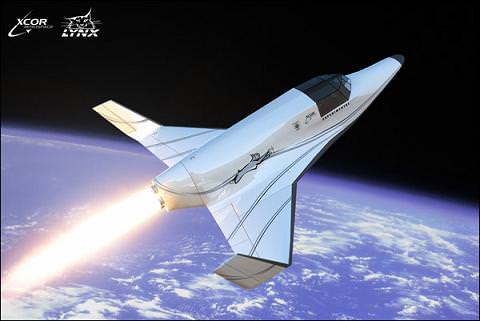This video provides a step-by-step explanation of the choreography needed to land NASA’s Curiosity rover on Mars. It starts with a computer simulation from NASA’s Eyes on the Solar System program and uses actual images from Curiosity’s Mars Descent Imager. It ends with a high-resolution color image from Curiosity’s Mast Camera. Entry, Descent and Landing team leader Adam Steltzner provides the play-by-play commentary.
Hubble’s Hidden Treasures Unveiled
A quick check of Hubble’s gallery shows just 1,300 images; however more than raw 700,000 images reside in a vast archive with hundreds of potentially jaw-dropping astronomical scenes just waiting to be uncovered. That was the idea behind the European Space Agency’s international contest called Hubble’s Hidden Treasures. And now with the hard work of amateur astronomers and more than 3,000 submissions, some of Hubble’s incredible celestial treasures are revealed.
“The response was impressive, with almost 3000 submissions,” the ESA said in a press release. “More than a thousand of these images were fully processed: a difficult and time-consuming task. We’ve already started featuring the best of these in our Hubble Picture of the Week series.”
The top 10 images selected in the Hubble Hidden Treasures basic imaging category. Top row: NGC 6300 by Brian Campbell, V* PV Cephei by Alexey Romashin, IRAS 14568-6304 by Luca Limatola, NGC 1579 by Kathlyn Smith, B 1608+656 by Adam Kill Bottom row: NGC 4490 by Kathy van Pelt, NGC 6153 by Ralf Schoofs, NGC 6153 by Matej Novak, NGC 7814 by Gavrila Alexandru, NGC 7026 by Linda Morgan-O’Connor
Credit: NASA & ESA
Judges ranked images from two categories, an image processing category and basic image searching category. Judges sifted through 1189 entries in the image processing category; a painstaking process of finding promising data and creating an attractive image using professional imaging software. But even if contestants didn’t have the technical know-how to create large mosaics and combine color filters, they could find stunning images in the Hubble archive using using simple online tools. The ESA received more than 1600 entries in this category.
“Every week, we search the archive for hidden treasures, process the scientific data into attractive images and publish them as the Hubble Picture of the Week,” says the ESA on their Hidden Treasures website. “But the archive is so vast that nobody really knows the full extent of what Hubble has observed.”
Josh Lake of the United States won with this awesome image of NGC 1763, part of the N11 star-forming region of the Large Magellanic Cloud.
First place in the processed category, which asked contestants to find promising data within the archive and process that scene into an attractive image, went to Josh Lake, from the United States. The image, which won the public vote, narrowly edged out other images. Lake produced a bold two-color image that is not in natural colors but contrasts light from glowing hydrogen and nitrogen. In natural colors, the two glowing gasses produce almost indistinguishable shades of red. Lake’s image separates them out into red and blue offering a dramatic view of the structure.
Messier 77 produced by Andre van der Hoeven, of the Netherlands came in a close second.
Andre van der Hoeven of the Netherlands came in a close second. The jury noted the impressive nature of Messier 77 in the image as well as the processing which combines several datasets from separate instruments to create the amazing image.
“This was my hardest job until now,” van der Hoeven says on the Flickr page. “Combining the different datasets to get equal colors was really hard. M77 was not fully covered by one dataset, so I had to combine channels of the WFPC2 with different wavelengths and tune the colors to get them to fit. But the result is in my opinion quite astonishing.”
We are as surprised as him that this image had not been released before.
Judy Schmidt of the United States entered this image of XZ Tauri, a new star lighting up a nearby cloud of gas and dust. She entered several images into the contest.
Third place went to an interesting image of XZ Tauri, a newborn star spraying gas into its surroundings as well as lighting up a nearby cloud of gas. The panel said it was a challenging dataset to process because Hubble captured only two colors in the region. “Nevertheless, the end result is an attractive image, and an unusual object that we would never have found without her help,” the panel said.
Revealing the challenge of many Hubble mosaics, the jury was impressed with the technical achievement Renaud Houdinet showed in putting together this ambitious view. He called this “The Great Mosaic Disaster in Chamaeleon. “Sometimes, things don’t turn out as they ought,” Houdinet admits on the Flickr description. Chamaeleon 1 is a large nebula near the south celestial pole and was not covered in one single Hubble image.
Robert Gendler took fifth place with an image of spiral galaxy Messier 96. You may know Gendler’s work as his version of Hubble’s image of NGC 3190 is the default image on the desktop of new Apple computers.
Top image caption: Top ten images selected in the Hubble Hidden Treasures image processing competition. Top row: NGC 1763 by Josh Lake, M 77 by Andre van der Hoeven, XZ Tauri by Judy Schmidt, Chamaeleon I by Renaud Houdinet, M 96 by Robert Gendler. Bottom row: SNR 0519-69 by Claude Cornen, PK 111-2.1 by Josh Barrington, NGC 1501 by kyokugaisha1, Abell 68 by Nick Rose, IC 10 by Nikolaus Sulzenauer. Credit: NASA & ESA
Links:
- Hubble’s Hidden Treasures
- Hidden Treasures image processing Flickr group
- Hidden Treasures basic imaging Flickr group
About the Author: John Williams is owner of TerraZoom, a Colorado-based web development shop specializing in web mapping and online image zooms. He also writes the award-winning blog, StarryCritters, an interactive site devoted to looking at images from NASA’s Great Observatories and other sources in a different way. A former contributing editor for Final Frontier, his work has appeared in the Planetary Society Blog, Air & Space Smithsonian, Astronomy, Earth, MX Developer’s Journal, The Kansas City Star and many other newspapers and magazines.
Multiple Dinosaur Tracks Confirmed at NASA Center
Fossilized nodosaur footprints discovered at NASA’s Goddard Space Flight Center in Maryland. (NASA/GSFC/Rebecca Roth)
At NASA’s Goddard Space Flight Center in Greenbelt, MD, where some of the world’s most advanced research in space technology is being performed on a daily basis, paleontologists have discovered ancient evidence of dinosaurs on the Center’s wooded campus — at least two, possibly a mother and child, crossed that way between 112 and 110 million years ago and left their muddy footprints as proof.
 The tracks of two nodosaurs — short, stocky and heavily-armored herbivorous dinosaurs — have been confirmed by dinosaur tracker Ray Stanford and USGS emeritus paleontologist Dr. Robert Weems. The second track is a smaller version of the first.
The tracks of two nodosaurs — short, stocky and heavily-armored herbivorous dinosaurs — have been confirmed by dinosaur tracker Ray Stanford and USGS emeritus paleontologist Dr. Robert Weems. The second track is a smaller version of the first.
The first, larger footprint was announced by Stanford on August 17. When Dr. Weems was called in to verify, the smaller print was discovered within the first, evidence that they were made around the same time and leading researchers to suggest it may have been a mother-and-child pair.
Dinosaur tracker Ray Stanford describes the cretaceous-era nodosaur track he found on the Goddard Space Flight Center campus with Dr. Robert Weems, emeritus paleontologist for the USGS who verified his discovery. (NASA/GSFC/Rebecca Roth)
“It looks to be a manus (front foot) print of a much smaller dinosaur than the first one, but it looks to be the same type,” Weems said of the second track. “If the one that came through was a female, it may have had one or more young ones following along. If you’ve seen a dog or cat walking with its young, they kind of sniff around and may not go in the same direction, but they end up in the same place.”
It’s thought that the nodosaurs were moving quickly since the tracks don’t show strong imprints of the animals’ heels. Still, the ruddy Cretaceous-era mud preserved their brief passage well — even as millions of years went by.
“This was a large, armored dinosaur,” Stanford said. “Think of it as a four-footed tank. It was quite heavy, there’s a quite a ridge or push-up here. Subsequently the sand was bound together by iron-oxide or hematite, so it gave us a nice preservation, almost like concrete.”
The next steps will be to have the site analyzed to determine whether further excavation is called for, and possibly to extract and preserve the existing footprints.
“Space scientists may walk along here, and they’re walking exactly where this big, bungling heavy armored dinosaur walked, maybe 110 to 112 million years ago.”
– Ray Stanford
Read more on the GSFC site here.
Reminder: Help Uwingu Begin a New Way to Fund Space Exploration
A couple of weeks ago we wrote about Uwingu, a creative, out-of-the-box concept to help solve what appears to be a growing problem for researchers, scientists, educators and students: how to get funding for research and other ground-breaking space exploration and astronomy projects. Why are a group of individuals from the space and astronomy community taking matters into their own hands to do this?
Alan Stern one of the founders of Uwingu, and the Principal Investigator for the New Horizons mission to Pluto, explained it quite well in today’s episode of the 365 Days of Astronomy.
“Well, it seems almost every year we have budget problems,” he said. “This year the planetary budget got cut 20%. Just last week a report came out cutting the National Science Foundation astronomy facilities, recommending those cuts. And every year it’s the economy or it’s an overrun with NASA, or it’s the President’s budget, or it’s something that happens in Congress. And in space research, in space education, unlike, for example, medical research or if you’re a weather researcher or many other fields, there really aren’t very many places to turn when NASA’s budget is cut or the NSF budget’s cut. That’s about it in terms of the funding portfolio. We like to say, you know, if you only own one stock, you probably deserve what you get when it goes down. We’re out to try and diversify that portfolio a little bit.”
UPDATE: Uwingu now has their own website!
The Uwingu team — and by the way, Uwingu means ‘sky’ in Swahili — has put out a new video about their project, and in doing so, reveal a little more about how they plan to create a new funding method. For two years, they’ve been designing and building software products that will be sold, and the proceeds will create the Uwingu Fund for space research, exploration and education.
Pamela Gay described their ideas as “so elegant that I can’t believe they haven’t already been done.”
Uwingu needs to raise about $75,000 to get their concept off the ground, and after that should be self-supporting, as well as supporting an impressive amount of other researchers every year.
So if you haven’t yet checked out Uwingu, here’s a little reminder to do so. Just head to their Indiegogo page and see what you think.
Telescope Review: Optics Planet Celestron Powerseeker 80EQ Refractor Telescope
Did you ever have a T-shirt that you really enjoyed and wore until you wore it out? How about a favorite pair of slippers? You know, the ones with the duct tape soles? Then I think you’re going to feel the same way about this telescope. It’s darn near the perfect combination of power, portability and price. Just right for casual observing… Be it on a rooftop or from your suburban yard. What makes it even more attractive is its ability to track its subject matter!
What’s new on the Tammy-testing homefront? This time it’s an Optics Planet Celestron PowerSeeker 80EQ refractor telescope. With 80mm of aperture and a 900mm focal length, it is not a small tube. It is elegant in both lines and size and does not appear “spindly”. Unlike most small aperture refractors which favor the alt/az, it comes with a light weight equatorial mount with a delightful addition – a drive unit. This means this special edition PowerSeeker 80EQ is going to make your time with lunar and planetary studies much more pleasant, and make higher magnification much more user-friendly.
Assembly is quite easy and fairly intuitive if you are familiar with telescopes and equatorial mounts. One thing you will very much enjoy is how easy it is to handle – a manageable 19 lbs. (8.62 kg) total weight. This means it is light enough to be set up complete and ready to be set outside the door at a moment’s notice. (This is something that I very much enjoy and approve of in a telescope. While I find large aperture to be breathtaking and I demand it for serious study, I also want a telescope that’s on hand for a quick look at the Moon or a joyous half hour with a planet.) While a light weight mount is super, don’t forget you’re making a trade-off. It’s not going to support heavy camera equipment and it’s not going to take a lot of abuse, such as overtightening or stressing gears through imbalance. However, it is quite capable of adding on certain types of imaging equipment, such as a webcam or eyepiece camera, or piggybacking a smaller camera on the mounting rings.
Next up? The view. As always, Celestron comes through with quality optics. At 80mm you’re not going to be getting Hubble images, but bright objects are crisp and clean. The views of Saturn and Mars were quite satisfactory and thanks to the included drive unit, the Celestron Powerseeker 80EQ delivered a whisper of the Cassini division and the neat little apparition of Titan swinging around the outside. Even Mars was capable of showing some dark patches when the atmosphere held still! Unfortunately, there wasn’t any Moon at the time, but I was very pleased with the color correction on beautiful double stars such as Cor Caroli and Albireo. Even Collinder 399 – the “Coat Hanger” showed pleasing red hints! Again, I was very appreciative of the drive unit when trying to split Epsilon Lyrae. With smaller aperture, the f/11 focal ratio could handle it – but again, needed the moment of perfect steadiness to say it was a clean split. No offense, but both the included 3X barlow and 4mm eyepiece are simply too much magnification for this scope to handle. (But a nice 10mm Plossl sure fills the bill!)
As for the scope itself, you’ll find it feels very “healthy”. The focuser isn’t a Feathertouch, but it has a nice feel to it… positive and it doesn’t slop around with a heavier eyepiece in it. The included 5×24 finderscope might seem a little small to most observers, but I liked it for two reasons – it’s an optical finderscope (not one of them (&^^#%! red dots) and it’s appropriately sized to what the scope can achieve. It’s just enough to pick off fainter “star hop” marker stars and give a hint of brighter objects. The included 1.25″ diagonal is also quite satisfactory and the 20mm eyepiece is the perfect workhorse for the majority of observations. You would be impressed with the crisp quality of the views of the Double Cluster, the ethereal Wild Ducks and the slightly pincushion look of M2.
Next up? Try kicking in better eyepieces and you’ll surprise yourself. Without getting brand specific, a higher dollar Plossl and a high magnification ED. Surprise, surprise! Here again, Celestron telescopes show their optical quality as the view did improve. After having become so accustomed to fast telescopes, it was a real pleasure to work with a longer focal ratio and see just how far I could push it. The Celestron Powerseeker 80 is definately deserving of higher quality eyepieces and a diagonal. All in all, this is an inexpensive telescope that is well made and, with care, should last through years of observing. You some day may end up with a little duct tape here and there…
But it’s got soul.
My thanks go to Optics Planet for their generous donation of the Celestron Powerseeker 80EQ to our annual star party / fundraiser at Warren Rupp Observatory.
SpaceX’s Next Cargo Run to Space Station in October
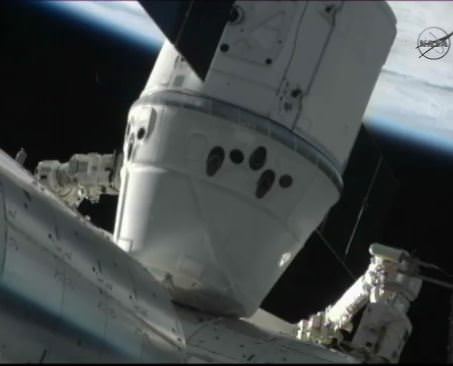
[/caption]
SpaceX is scheduled to launch the first of its 12 contracted cargo flights to the International Space Station in October, 2012. NASA Administrator Charles Bolden announced Thursday at Kennedy Space Center that SpaceX is now fully certified to ferry cargo to the space station. While the company’s Dragon capsule did bring cargo to the ISS during its initial flight in May, that was considered just a test flight. Now comes a series of ‘real’ cargo runs.
Bolden also announced some other commercial milestones under NASA’s Commercial Resupply Services Program that “progress toward a launch of astronauts from U.S. soil in the next 5 years,” he said.
“We’re working to open a new frontier for commercial opportunities in space and create job opportunities right here in Florida and across the United States,” Bolden said. “And we’re working to in-source the work that is currently being done elsewhere and bring it right back here to the U.S. where it belongs.”
Bolden also announced NASA partner Sierra Nevada Corp. has conducted its first milestone under the agency’s recently announced Commercial Crew integrated Capability (CCiCap) initiative. The milestone, a program implementation plan review, marks an important first step in Sierra Nevada’s efforts to develop a crew transportation system with its Dream Chaser spacecraft.
CCiCap is an initiative of NASA’s Commercial Crew Program (CCP) and an Obama administration priority. The objective of the CCP is to facilitate the development of a U.S. commercial crew space transportation capability with the goal of achieving safe, reliable and cost-effective access to and from the space station and low Earth orbit. After the capability is matured, it is expected to be available to the government and other customers. NASA could contract to purchase commercial services to meet its station crew transportation needs later this decade.
What Are The Radiation Belts?
NASA’s twin Radiation Belt Storm Probe (RBSP) satellites, scheduled to launch from Cape Canaveral Friday, August 24* at 4:08 a.m. ET, will enter into an eccentric orbit around our planet, repeatedly passing through both of the Van Allen radiation belts that surround Earth like enormous high-intensity particle filled inner tubes. The plasma contained within these belts can affect satellites, spacecraft and communication here on Earth, and are affected in turn by outbursts of solar energy from the Sun — especially during periods of solar maximum. But how do these invisible yet powerful radiation belts actually work, and how will two six-foot-wide satellites help us learn more about them? Watch the video.
(And then read more here.)
Video: NASA
*UPDATE: After several delays due to weather and technical issues, the RBSP mission successfully launched on Thursday, August 30.
With Proposed Cuts, Can the US Continue to be a Leader in Astronomy? Q & A with NOAO Director David Silva
The Kitt Peak Observatory
Last week, a report issued by the National Science Foundation’s Division of Astronomical Sciences suggested de-funding several ground-based observatories along with other money-saving strategies to help offset budget shortfalls in US astronomy which have been projected to be as much as 50%. The report recommended the closure of iconic facilities such as the Very Long Baseline Array (VLBA) and the Green Bank Radio Telescope, as well as shutting down four different telescopes at the Kitt Peak Observatory by 2017.
Universe Today talked with the Director of the National Optical Astronomy Observatory (NOAO), Dr. David Silva for his reactions to the report.
Universe Today: What is your initial reaction to the STP portfolio review:
David Silva: “It’s disappointing, but not completely unexpected. I think the biggest challenge for the overall US community is they’re going to lose access to a lot of world-class, cutting-edge facilities. This is roughly somewhere between eight hundred to a thousand nights of open access time which is going to be defunded over the next three years or so. That’s a huge culture change for US astronomy.
UT: Do you see this affecting the researchers at smaller facilities and universities the most?
Silva: Definitely. Clearly, the situation is now that if you’re at an institution that has its own facility, everything should be OK. But if you’re at an institution that does not have access to its own facility, you’re in a bad situation. So that naturally segregates the bigger universities versus the smaller universities.
I should say there is a caveat, in that we are in an era now in professional astronomy where surveys are now becoming a much stronger component of what we do. Surveys are the big wide-field surveys both from space and from the ground which are producing massive datasets that are open to everyone. So, what’s really happening is this culture change from people having to compete for one or two nights a year on a telescope to potentially working on the big datasets. So, how that transition occurs remains to be seen. But the loss of all these open access nights will definitely be a shock to the system.
UT: Do you see the new report as being overly pessimistic or do you think it’s spot on of what’s actually going to be taking place in astronomy next few years, such as in one scenario which described that only 50% of projected funding will be available?
Silva: I have no opinion on that. That was a boundary condition that the report used, and if I could predict that I would be in a different industry!
UT: Do you see any potential silver lining here, that this kind of tight funding could streamline things, or could help in the “persistent mismatch between the production rate of Ph.D.s and the number of tenure-track faculty or long-term astronomy positions” that the report talked about?
Silva: No. I think the higher-level issue is that astronomy in the last 20 years has been a field where the number of people who are professional astronomers has grown in this country because of a fortuitous funding cycle from all three of the major funding agents, NASA, NSF and the Department of Energy. But we are now in a downward cycle in funding for astronomy at the federal level and there is going to be a squeeze now. I think that one of the choices we’re going face as there is this squeeze and people begin to leave the field, how do we make sure that the those who are still in the field — especially our younger colleagues – that they are given the mentoring and nurturing and support they need to have vital careers.
But there’s a growing mismatch between the numbers of people who want funding and the funding that is available, there’s no two ways about it.
UT: Any final thoughts or things that you think are people I’m important for people to know about?
Silva: One of the opportunities that it creates on Kitt Peak is the ability to continue to move forward on our BigBOSS collaboration, which is a proposal to put a 5,000 target, multi-object spectrograph on the 4-meter Mayall telescope at Kitt Peak National Observatory, which allows you to do a large dark energy characterization experiment. The instrument is also exceptionally powerful for doing a variety of other investigations like galactic archaeology to map out kinematics in the galaxy, the chemical composition and the motions of galaxies and stars, and other very large data projects like that.
This report was actually quite supportive of that project moving forward. So even though reports recommend the NSF divest funding in the Mayall Telescope as an open-access telescope, it suggests there are ways forward to convert it from an open access platform to a survey facility. And that’s, I think, a silver lining in this. It doesn’t solve that cultural issue, but it was does mean we can continue to do high impact science with that instrument.
But I do see this as a big cultural change. A key question perhaps is, does the US have strong national observatory or not? And this report is leaning in the direction of not.
You can read an initial statement from NRAO (National Radio Astronomy Observatory) and AURA (Association of Universities for Research in Astronomy) on the AST report here, and another following statement from AURA here.
How Planetary Resource’s Asteroid Search Could Help Find Exoplanets
Planetary Resources is the private company that wants to eventually mine asteroids for profit. But initially, the group will focus on developing Earth orbiting telescopes to scan for the best asteroids, and then later, create low-cost robotic spacecraft for surveying missions and then actual spacecraft to do the mining.
But in the meantime, Planetary Resources has opened up the option of allowing access to their Arkyd-100 space telescope to others, and put out the question: “What would you do if you had access to our Arkyd-100 space telescopes?”
An MIT Researcher said he could use the Arkyd telescope to find alien planets.
Dr. Vlada Stamenkovic, a post-doctoral researcher at MIT who searches for exoplanets – distant alien worlds beyond our solar system — sent in this video to Planetary Resources with his explanation:
“It’s inspiring to think that the Arkyd can help researchers like Vlada discover Earth-like planets, and perhaps, someday, even life out there among the stars,” Planetary Resources said on their website. “We’re excited to see such enthusiasm around our projects.”
Another of the aims of Planetary Resources is to open deep-space exploration to private industry, much like the $10 million Ansari X Prize competition, which Planetary Resources member Peter Diamandis created. In previous talks, Diamandis has estimated that a small asteroid is worth about “20 trillion dollars in the platinum group metal marketplace.”
If you have something smaller in mind, perhaps similar to the proposal by Stamenkovic, Planetary Resources has opened up the possibility for anyone to submit a request for using their telescopes. If you have an idea, record a 90-second video on how you’d like to use the Arkyd-100, and share it with Planetary Resources. That can be done by creating a video response to this You Tube video or adding a link to your video on PRI’s website.
“Tell us the WHAT and the WHY. The videos getting the most likes will drive elements of our Kickstarter Campaign and get posted to the PRI website.”
Lead image caption: Artist concept of the Arkyd-100 series telescope. Credit: Planetary Resources.
XCOR to Move Operations Near Kennedy Space Center
Kennedy Space Center is getting a new neighbor: XCOR Aerospace announced they intend to establish an operational base in Florida, and also hope to build a manufacturing and assembly center for the XCOR Lynx Mark II suborbital reusable launch vehicles.
“Looking over the KSC Visitor Complex grounds and seeing the history of U.S. human spaceflight and realizing that soon XCOR will be a part of the fabric of the Space Coast is very exciting to me personally and our company” said Jeff Greason, XCOR CEO. “When we started the company back in 1999, we could only have dreamt about the possibility of flying the person on the street or the citizen scientist to space from such an important place.”
KSC and NASA officials — as well as local officials dealing with the job losses from the end of the shuttle program — were thrilled with the news. XCOR’s new operations in Florida could bring new work for highly skilled former space shuttle employees.
“The next era in space exploration is under way, and the Space Coast of Florida is ground zero in the Obama administration’s effort to launch Americans from U.S. soil and create good jobs that support an economy built to last,” said NASA Chief of Staff David Radzanowski. “The region continues to be a key strategic location for companies, like XCOR, who want to build on our nation’s great legacy of innovation and entrepreneurship.”
“We look forward to discussing with XCOR Aerospace and other space companies how Kennedy’s unique capabilities may be made available for use,” said Kennedy’s Center Director Bob Cabana. “This is further evidence that the Space Coast is preparing for the next era of space exploration.”
XCOR made the announcement in Florida, with the Kennedy Space Center Visitor Complex as a backdrop.
The company hopes to fly the Lynx suborbital vehicle from Kennedy Space Center’s Shuttle Landing Facility, the Cecil Field Spaceport, or other suitable Florida locations by 2014. And if all goes well, they will also start building facilities to produce parts for the Lynx Mark II models and eventually production of Lynx vehicles and other XCOR products, “should market demand materialize and the emerging commercial space industry maintain its current momentum,” XCOR said in a press release.
They estimate direct job creation through late 2018 at just over 150.
“As chair of Space Florida, this is the type of investment the Space Florida Board has been working on to attract high-tech, high-wage jobs to Florida,” said Florida Lt. Governor Jennifer Carroll. “We are very pleased to welcome XCOR to Florida as a prime example of how utilizing Florida’s existing infrastructure and leveraging our talented workforce capabilities can attract new and growing business to our state.”
NASA said they are working with XCOR and other commercial space companies so that KSC could be host to many kinds of spacecraft and rockets in the future.
“Negotiations are taking place with other commercial users for Orbiter Processing Facility Bays 1 and 2, as well as with potential commercial users of the Launch Complex 39 launch pads,” NASA said in a statement. “These and other partnerships will cement Kennedy as a true multiuser spaceport as envisioned by our nation’s leadership.”
Lead image: XCOR’s Lynx suborbital vehicle. Credit: XCOR


